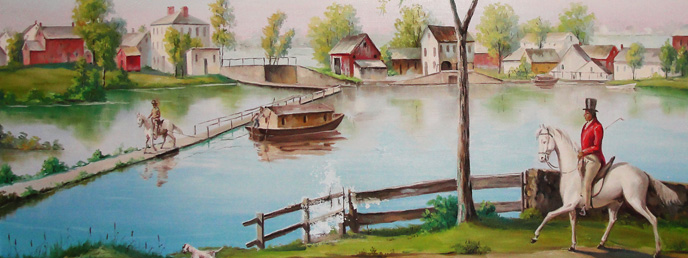


Middlesex Canal Association P.O. Box 333 Billerica, Massachusetts 01821
www.middlesexcanal.org
| Volume 56 No. 1 | October 2017 |
Please mark your calendars
MCA Sponsored Events
15th Bicycle Tour North, 9:00am, Sunday, October 1, 2017
Fall Walk, 1:30pm, Sunday, October 15, 2017,
Billerica Museum South
Fall Meeting, 1:00pm, Sunday, October 22, 2017
Speaker Bill Kuttner
History in Modern Surroundings
Special Event, 3:00pm, Monday, October 30, 2017
Bill Gerber speaking before the Genealogy Club
at the Amesbury Library - Registration Required
Winter Meeting, 1:00pm, Sunday, February 11, 2018
TBA
The Visitor/Center Museum is open Saturday and Sunday, noon – 4pm, except on holidays.
The Board of Directors meets the 1st Wednesday of each month, 3:30-5:30pm, except July and August.
TABLE OF CONTENTS
MCA Sponsored Events and Directions to Museum
President’s Message - Tribute to Thomas Raphael - J Jeremiah Breen
Remembrances of Tom Raphael - Neil Devins
Treasurer Emeritus - Betty Bigwood
Two Old Elm Street - Betty Bigwood
MCA Annual Meeting Report - Deb Fox
A Social History of the Middlesex Canal by Alan Seaburg: a Book Review - Howard Winkler
Delilah Identified - a book review of Billingsley, Brampton and Beyond - In Search of the Weston Connection by Pamela Gardner - Howard Winkler
Provenance of the Spade - Bill Gerber
News from the MCC Billerica Section
Editors’ Letter
Dear Readers,
Welcome to the Fall 2017 issue of the Towpath Topics. While the upcoming events list should be the first focus for all of you, we would also like to point out some other interesting items in this issue.
Past events and on-going news are somewhat relative when a publication is quarterly. Everything recapped happened so far in the past that it is no longer remembered and is “old news.” How about if we consider it “reliving our recent past?” In that vein, read about land gifts to the MCA, a clean-up of the High Street site, and the Annual Meeting in April. Included also is the obituary of Mary Stetson Clarke, provided by the speaker Susan Sexton Clarke, her daughter.
There are historical articles too! Bill Gerber has researched the origin of the Baldwin spade on display at the Middlesex Canal Museum and Betty Bigwood has contributed a biography of revered treasurer emeritus, Howard Winkler. Now that Howard has retired we are expecting him to supply us with many articles, for every issue.
This issue contains two book reviews by Howard as well as an update on the status of the planned renovation of the proposed new museum site at 2 Old Elm Street by Betty Bigwood.
Sadly, we note the passing of our esteemed leader and inspiration, Tom Raphael. A copy of Neil Devins Facebook post eulogizing Tom is reprinted herein along with a moving tribute to Tom by President J Breen.
The Editors
MCA Sponsored Events and Directions to Museum
15th Annual Bicycle Tour North: The 15th Bicycle Tour of the Middlesex Canal Association will take place on Sunday, October 1, 2017 led by Dick Bauer and Bill Kuttner. Riders should assemble at 9:00am at the Middlesex Canal Plaque at the entrance to the Sullivan Square T Station (1 Cambridge Street, Charlestown 02129). The tour will head north following the route of the Middlesex Canal. Due to unavailablity of the Lowell train this year, it is expected that this year’s ride will only go as far north as Wilmington before turning back and riding back to the Boston area. For additional details and updates see www.middlesexcanal.org.
Fall Walk: This walk is jointly listed as a local walk of the Boston Chapter of the Appalachian Mountain Club and the Middlesex Canal Association. On Sunday, October 15, 2017 those planning to join the walk should meet at 1:30pm at the Middlesex Canal Museum and Visitors’ Center on 71 Faulkner Street in North Billerica. The walk will take 2-3 hours, rain or shine, over generally level wooded terrain and streets. The route follows the canal for a round trip of approximately 3 miles south of the Concord River. Sites to be visited include: two guard locks; an anchor stone and the ‘peninsula’ at the opposite ends of the floating bridge that once carried the towpath across the Concord; the 1825 iron bolt pond-level reference; the “deep cut”; a smallpox memorial marker; and stretches of canal some of which are still watered. The walk will be led by Robert Winters and Marlies Henderson. For more information please visit www.middlesexcanal.org.
Fall Meeting: On Sunday, October 22, 2017 at 1:00pm the Middlesex Canal Association will hold a public meeting at the Middlesex Canal Museum and Visitor Center, 71 Faulkner Street, North Billerica, MA. Bill Kuttner, the featured speaker, is a transportation planner at the Central Transportation Planning Staff (CTPS) in Boston where he works on a range of studies often focusing on freight transportation. He grew up in southern California where he sought out Spanish missions and remnants of Red Car lines, and rowed a boat in Long Beach harbor to try to get a peek of the Spruce Goose when it was Howard Hughes’ personal property.
Bill moved to New England in 1975 to attend M.I.T. Today he serves on the boards of the Shirley-Eustis House (www.shirleyeustishouse.org) and the West End Museum (www.thewestendmuseum.org).
He has also developed an interpretive map which is now on display by the Norman B. Leventhal Map Center https://collections.leventhalmap.org/search/commonwealth:7h149v32x.
Bill helps lead the twice-yearly Middlesex Canal bicycle explorations, and is always on the lookout for any overlooked or underappreciated infrastructure that helps explain today’s built environment.
Please see the MCA website for more information on Bill Kuttner’s scheduled lecture History in Modern Surroundings.
Special Event (Amesbury Public Library): Bill Gerber’s presentation will provide an overview of the Merrimack River as an artery of transportation, and shows and describes what remains of the system today. Before they were adapted to power New England mills, the falls and rapids of the Merrimack River were serious obstructions to travel. These impediments, and the absence of good roads, drove more than a decade of efforts to improve river navigability. Between 1792 and 1848, nine companies constructed 13 canals, incorporating 36 locks, along the main river channel between Concord, NH and the sea or, via the Middlesex Canal, to Boston. Lesser improvements were made by a few of these companies at several more rapids. Additional canals were built by still other firms near the mouths of the Nashua and Piscataquog Rivers, and possibly at one or more industrial sites.
The event is funded by the Friends of the Amesbury Library and will be held on Monday, October 30, 2017 at 3:00pm at the Amesbury Public Library. Registration is required. For more information contact Margie Walker at 978-388-8148 or mwalker@amesburylibrary.org.
Directions to Middlesex Canal Museum and Visitors’ Center
By Car: From Rte. 128/95
Take Route 3 toward Nashua, to Exit 28 “Treble Cove Road, North Billerica, Carlisle”. At the end of the ramp, turn left onto Treble Cove Road in the direction of North Billerica. At about ¾ mile, bear left at the fork. After another ¾ mile, at the traffic light, cross straight over Route 3A (Boston Road). Go about ¼ mile to a 3 way-fork; take the middle road (Talbot Avenue) which will put St Andrew’s Church on your left. Go ¼ mile to a stop sign and bear right onto Old Elm Street. Go about ¼ mile to the falls, where Old Elm Street becomes Faulkner Street; the Museum is on your left and you can park across the street on your right, just beyond the falls. Watch out crossing the street!
From I-495
Take Exit 37, North Billerica, south roughly 2 plus miles to the stop sign at Mt. Pleasant Street, turn right, then bear right at the Y, go 700’ and turn left into the parking lot. The Museum is across the street (Faulkner Street).
By Train:
The Lowell Commuter line runs between Lowell and Boston’s North Station. From the station side of the tracks at North Billerica, the Museum is a 3-minute walk down Station Street and Faulkner Street on the right side.
President’s Message - J. Jeremiah Breen
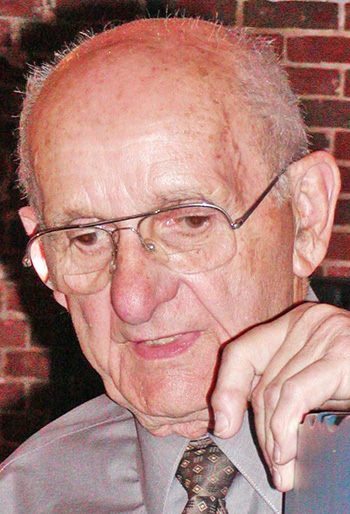 A Stalwart of the Middlesex Canal
A Stalwart of the Middlesex Canal
Tom Raphael passed on Sunday, 27 Aug 2017, age 95.
“What terribly sad news; a wonderful man who accomplished so much in his life. A leader; inventor; chemist; a tireless worker for and proponent of the Canal’s preservation and making the public aware of how important it was historically to this area and country. I’m sure he worked on something Canal related even on his last day. . . . He was someone to emulate; even on my best days I don’t think I have his energy.” – Neil Devins
The earliest record of Tom in Towpath Topics is September 1989 when a report was made on his offer to see what he could do with Fred Lawson’s antique glass lantern slides. Tom’s interest in photography began in 1934 when he earned his photography merit badge. Sydney Towle, the scoutmaster, was a locomotive engineer and amateur photographer who insisted scouts in Somerville Troop 9 earn that merit badge. Tom bought a 35-mm camera then and later always had a darkroom for developing photos in houses he owned. He retired in 1985 as a director of research at Polaroid Corp. When he offered to see what he could do, with glass slides, he was modest in anticipating what he could do.
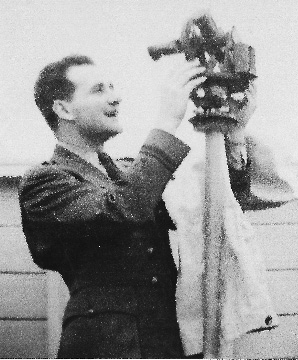 Tom Raphael - Navy Meteorologist, WWII |
Most of the details above are from a 2½ hour talk by Tom about his life, videotaped by Roger Hagopian with prompting by Betty Bigwood and Tom Dahill, paid for by the Billerica Section of the Middlesex Canal Commission. Those who only knew Tom in the last decade or two, when he epitomized success through effort and intelligence, would be surprised at how much in his first sixty years of life he attributes to coincidence and good fortune. Again, he was modest.
Tom likely joined the association in 1985, the year he retired from Polaroid, age 63. (See 1 below) He became a director in 1989.
In 1995, Tom learned of the Federal Highway Administration’s transportation enhancement program which would fund, among other things, the rehabilitation and operation of historic canals. Significantly, the money for transportation enhancements was 10% of the federal gas tax money given to Massachusetts each year. Millions were available for “Transportation Enhancements” in Massachusetts.
In March 1996, after being appointed to the Middlesex Canal Commission by the Town of Winchester, Tom was elected chairman of the executive committee. Later, the Northern Middlesex Council of Governments budgeted $3 million of gas tax for the Middlesex Canal. For twenty years, until his last meeting in March 2016 as chairman of the annual meeting of the commission, he had striven to enhance the Middlesex Canal with a park at the summit pond above the Billerica Falls Dam as described in the 1980 MC Heritage Park Feasibility Study. The Billerica park has hung as 50 plan sheets at the pre-25% design level with Tom unable to overcome the changing requirements for approval to get the $3 million budgeted for the park.
The visitor center/museum in the 1980 feasibility study was opened in 2001, just five years after Tom rejuvenated the Middlesex Canal Commission. Some to emulate: take on a chairmanship at age 73.
Notes:
1. In Tom’s video, he says he became a proprietor when he went with Dave Dettinger to an association meeting at a Unitarian Church, mentioning that no fence separated his house from Dave’s and the two families’ children played together. Dave signed the association’s articles of incorporation in 1963. The two families lived 100’ apart, separated by a paper street, until Tom moved in 1967. Yet Tom is first mentioned in Towpath Topics in 1989. Improbable that Tom was a passive member for twenty years. Likely he went with Dave to the fall meeting at Winchester’s Unitarian Church in 1985, the same year he retired, and joined then.
2. Tom was born June 9, 1922, on Franklin St. in Somerville, MA, the youngest of four children. His parents were immigrants from Albania. His father died at age 52 when Tom was ten. His teachers at Somerville High said he would go to Harvard if he kept up the good work. He entered Harvard in 1940 with a full tuition scholarship.
Remembrance of Tom Raphael
by Neil Devins
It is with a bit of shock and a heavy heart that I (Neil P. Devins, MCA Board Member, Middlesex Canal Commission representative, and producer of the MCA Facebook page) need to announce to the Middlesex Canal Museum visitors and those of you directly involved with either the Commission (a Massachusetts governmental agency) or the Middlesex Canal Association (volunteer non-profit organization) that our de facto overall leader, Mr. Thomas Raphael, passed away on Sunday, August 27, 2017, at the age of 95. One might wonder why “shock.” If you knew him, you had the impression that he would just go on and on. His obituary notice:
RAPHAEL, Thomas Of Winchester passed away peacefully on August 27, 2017. Beloved husband of late Elva W. (Holmes) Raphael. Loving father of William G. Raphael of Wakefield, Constance J. Raphael and her husband Kenneth W. Leach of Medford, the late Allan T. Raphael and his wife Suzanne of Blue Point, NY and the late David G. Raphael. Dear grandfather of Pamela S. Raphael of Blue Point, NY. At the family’s request all services will be private. Late veteran US Navy WWII. For online condolences please visit www.lanefuneral.com
My initial reaction: What terribly sad news; a wonderful man who accomplished so much in his life. A leader; inventor; chemist; a tireless worker for and proponent of the Canal’s preservation and making the public aware of how important it was historically to this area and country. I’m sure he worked on something Canal related even on his last day. He was someone to emulate; even on my best days I know I don’t have his daily energy.
Quite soon after Tom heard about the Canal at a historical society lecture, he quickly decided that reactivation of the Middlesex Canal Commission was essential in order to meet the goals of the MCA and the Commission: To acquire, restore, and preserve all extant remains of the Middlesex Canal; to establish a museum devoted to the history of said canal; to establish along the route of said Canal a park or parks for public recreational and educational use; to engage in historical research and to publish historical, literary, and scientific works concerning said canal including the area served by it and the era during which it was active. The Commission’s goal was even more specific: to build a Middesex Canal Heritage Park.
Tom, as much as anyone I was aware of, got to work immediately. He was the President of the MC Commission since its re-inception, and quickly got to work building relationships with State Representatives. He applied for and won a tremendous grant, (more than $400,00) while describing, at minimum, his vision of a Heritage Park (the plan which resides in the museum at all times) at the Millpond in North Billerica and the adjacent area. Unfortunately, all of this money was co-opted by the DOT and diverted to the most recent “Big Dig.” He tirelessly fought the multitude of forces by the State, individual canal towns, Conservation Commissions, you name it; using energy he seemed to have an endless supply of. A wonderful quality he had was to present a respectful assertiveness to an endless array of politicians seeking to thwart our goals, not easily accomplished by many. There had been an original Heritage Park study completed in 1980 which described the route of the Canal as accurately as possible, and the major outcome of that endeavor was that Brass Plaques were designed, and placed in critical areas along the route in each of the nine canal communities. The Heritage Park was proposed, yet no real action taken on its construction given the aforementioned loss of money to the DOT. Tom engaged another archaeological/architectural organization to update that study, proposing extant portions of the Canal that would be the most likely candidates for rehabilitation. His top priority became seeing to it that the path to ultimately building a park at the Billerica mill pond, with a reconstructed portion of the canal and a lock would eventually become a reality.
Thus, during his tenure, he could be both a guiding force as well as a first-person participant. With the lion’s share of the construction performed by the Billerica section of the MCC, a wonderful Museum was established and opened in 2001. The laws re-authorizing the existence of the Middlesex Canal Commission were officially laid down, (certainly with the intent that the Commission would have the “teeth” to avoid the multiple pitfalls of Town Governments overruling us). The Mass. Historical Commission in 1996 suggested that the complete length of the Canal be recorded in the National Register. While I’m personally not certain of the correlation, it seemed to me that the updated rigorous study of the canal route led to a natural progression of Tom’s next goal of achieving what Mass. Historical had suggested, with the entire route of the canal, extant or not, placed on the National Register of Historic Places. In the 1970s, only the route of the canal from Woburn to the Merrimack River had achieved that designation. Tom, in his 80s now, worked closely with this firm in initiating the highly formidable and complex task of having the entire route of the Middlesex Canal depicted as accurately as possible, using assessors’ plates and land Deeds to construct accurate maps which met the myriad rules that the National Register people demand. He was also making presentations in the nine Canal town Selectman/Alderman meetings to help generate as much cooperation as needed. The wonderful outcome: On November 19, 2009 the “Middlesex Canal Historic and Archaeological District,” from Lowell – Boston, Massachusetts was accepted for inclusion in the National Register of Historic Places.
Certainly, there are many other 20-30 year Board or former Board members who have contributed mightily to the MCA and MCC missions. I wish to acknowledge the contributions of an individual whose, intellect, determination, and cooperative spirit helped our organizations attain many wonderful achievements. Tom Raphael’s energy came naturally to him, or so it seemed to me, as did all of the aforementioned adjectives did. I mentioned early on that he was an inventor as well. At age 94, he was awarded a patent for a tricycle for the elderly. Please have a look at the following video clip to catch a glimpse of Tom Raphael’s spirit. He will be greatly missed.
Treasurer Emeritus
by Betty M. Bigwood
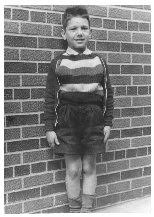 |
| Howard Winkler, 1938 |
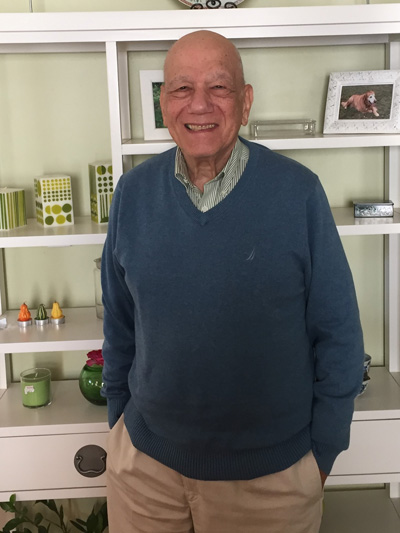 |
| Howard Winkler, 2017 |
“What’s in a name?” This one is very special. At the Annual meeting Howard B. Winkler stepped down from his position as Treasurer – after almost thirty years in the position. He had given us ample time – 2 years – to select someone else - nevertheless convincing someone to follow such a storied career would prove daunting. Fortunately for us Director Russell B. Silva has graciously taken the position. Russ is happy that Howard has stayed on the Board to ease the transition.
Our first President, Lou Eno, and first Treasurer, Malcolm Choate told stories about how they started the Middlesex Canal Association by “passing the hat” whenever funds were needed. Under Howard we started the Annual Appeal, our Endowment Fund, investments in the stock market, and monthly organized spread sheets. There were countless personalized thank you notes to generous donors, keeping track of our tax-exempt properties and satisfying the Commonwealth of our tax exempt status filings.
Earlier this year, there was a unanimous vote by the Board of Directors to grant Howard the special title of Treasurer Emeritus. Howard had a huge grin on his face and an aura of dignity so we knew he loved it! Good job! It has a ring to it: Howard B. Winkler, Treasurer Emeritus.
Two Old Elm Street
by Betty M. Bigwood
Two Old Elm Street was given to the Middlesex Canal Association by Pace Industries (Donohue – local CEO) in February 2014. Tom Raphael brokered the arrangement – we will miss his wise counsel. The Board of Directors of the MCA voted to accept it. The hope is to build a Middlesex Canal Museum.
President J. Breen, Thomas Raphael and Marlies Henderson attempted to start the building project months ago by applying for a Cummins Grant which was unfortunately denied. We have been raising money ever since to start again. The roof has deteriorated badly prompting a sense of urgency.
In May, a Building Committee (Raphael, Breen, Dahill and Bigwood) was started. There have been numerous meetings and we now have a plan. Tom Dahill has drawn two sketches which describe what the building will look like and floor plans – a work in progress. On August 28, 2017 we signed an initial agreement with John P. Caveney, a young (27 years old) architect to start drawing conceptual plans for the project. In addition we have hired a wetlands professional Scott Smyers of Oxbow Associates, Civil Engineer Robert Gill and Structural Engineer Paul Phelan. By the end of October we should be ready to approach the various Billerica Boards for their approvals – if granted we should be on our way.
The first stage is to have a weather tight building with plans for a bridge and second entrance. Once over this hurdle we can proceed as available money allows. This may mean we will initially complete the first floor and move in. There are many challenges ahead which we are approaching with optimism.
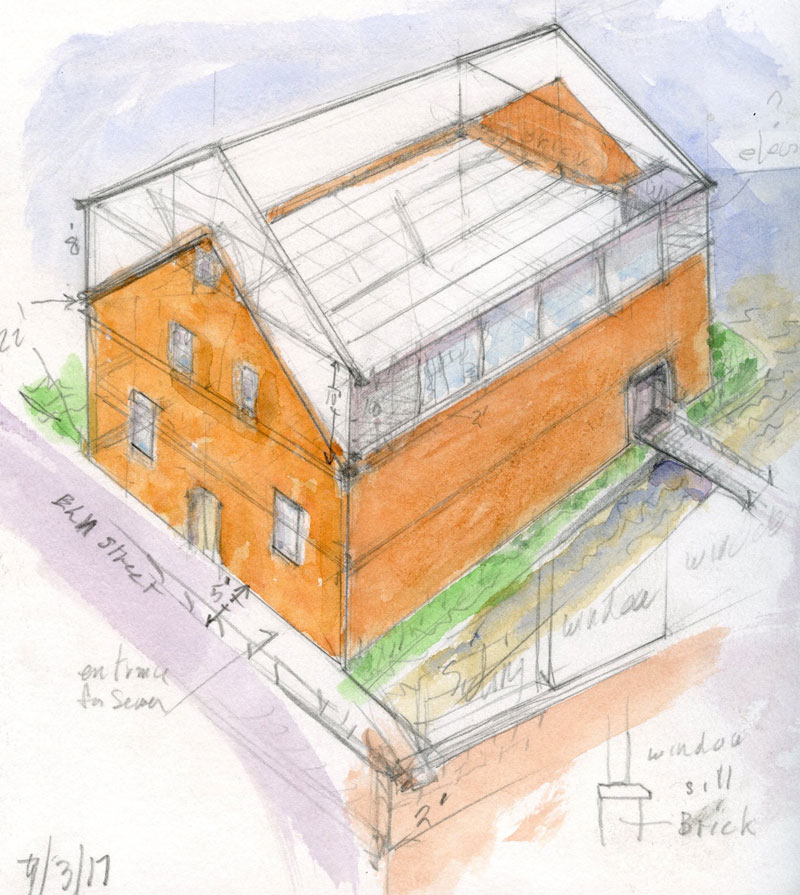
MCA Annual Meeting - April, 2017
by Deb Fox
The Old Middlesex Canal by Mary Stetson Clarke might be considered the “textbook” for the Middlesex Canal volunteers. It is read and reread by everyone, and is constantly referenced for any questions asked by visitors, or to calm any dispute among those volunteers. It was with great excitement that the news of her daughter, Susan Stetson Clarke’s agreement to speak at the Annual Meeting about her mother, was received by the Board Members of the MCA.
However, since it was the MCA Annual Meeting, business had to come first. So on April 30, 2017 at 1:00pm, the meeting was called to order with the now traditional blowing of the conch shell by President J. Breen.
There were two main items on the business agenda. The first was a vote for the by-law changes that were described in the winter issue of Towpath Topics. A 2/3 vote of a quorum was needed to pass, and it passed unanimously. The 2nd item was an election of officers for the next year. These included: J. Breen, president, Traci Jansen, vice president, Neil Devens, membership secretary, and new treasurer, Russ Silva, to replace retiring Howard Winkler, after 29 years of service. The position of secretary will remain open at this time, as Jean Potter has resigned for medical reasons and a replacement has not stepped forward to take the position. {Jean’s dedication to MCA was recognized by a vote to install her as an honorary director.} New Board members include:
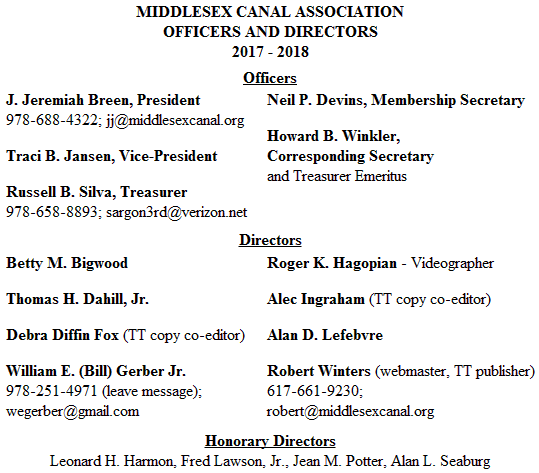
The Finance Committee will now consist of J. Breen and Bill Gerber. [Tom Raphael would also have been on the committee, so there may be a need for an additional person.] All nominations were approved unanimously.
The meeting officially over, Betty Bigwood then stepped forward to introduce Susan Stetson Clarke. The appended obituary highlights the accomplishments and milestones of Mary Stetson Clarke’s life. Ms. Clarke embellished these accomplishments with information about her mother’s struggles to get published and their family, especially her husband, who encouraged and supported her career. While she maintained a household of three children in a traditional 1950’s and 60’s way: cooking, sewing, canning, and knitting for them, she was clear that “only a housewife” was not an acceptable phrase to use around her. She demanded respect by dressing professionally and always being addressed as “Ms. Clarke.”
This glimpse into the life of Mary Stetson Clarke was greatly enjoyed by all in attendance, and their admiration and respect for her life and work grew immeasurably. Audience members responded with questions and remembrances which added to the experience. Following the enjoyable and lengthy question and answer session the usual spread of food and drinks concluded the afternoon. A good time was had by all!
In Memoriam
Mary Stetson Clarke
1911-1994
We note with sadness the passing of our beloved Mary Stetson Clarke. She died at home in Scituate, Mass. on November 12, 1994 at the age of 82.
Mary and her husband Edwin were for many years active directors on the Board of the Middlesex Canal Association. She is best known by us and by canal buffs generally as the author of The Old Middlesex Canal, which was published in 1974 and is currently in its second edition. It is a comprehensive history of the Middlesex Canal, complete with illustrations, facsimile documents, extensive bibliography, and a guide for following the route of the Canal.
Mary lived most of her life in Melrose, where she and Edwin raised their family of two daughters and a son. Mary was active in various organizations in Melrose, including the library of which she was a trustee for 21 years, 7 as chairman. The Mary Stetson Clarke Trust has been established there in her memory. Also, she was an active member of the Melrose Conservation Commission, Trinity Church of Melrose, Melrose Hospital Society, the local chapter of the American Association of University Women, and the League of Women Voters. She graduated from Boston University in 1933 with a bachelor’s degree in English literature and did graduate work at Columbia University. She was elected to the Collegium of Distinguished Alumni of Boston University’s College of Liberal Arts.
Mary was 40 when she started writing books. She was the author of several books of historical fiction and nonfiction. Nonfiction books, in addition to The Old Middlesex Canal, included Pioneer Iron Works (still used as a text for guides at the Saugus Iron Works), and an anthology about her ancestors, Russells in America: 1640-1988. Her historical novels included Petticoat Rebel, Bloomers and Ballots, Limner’s Daughter (early years of the Middlesex Canal), Piper to the Clan, The Glass Phoenix, The Iron Peacock, and A Visit to the Iron Works (for children).
Upon moving to Scituate 5 years ago, the Clarkes discovered that their daughter’s church in neighboring Norwell is built on land given to the church some 350 years ago by Cornet Robert Stetson, one of Mary’s ancestors. She also descended from Caleb Stetson, minister of this church from 1848 to 1868. So, with her sense of history and considerable quiet pride, Mary joined the First Parish Unitarian Church in Norwell, and it was there that her memorial service was held.
Mary Stetson Clarke was an inspiration to all who knew her. Her memory and the influence of her writings will continue for many more years. But members of our Association and her other friends will miss her warm friendliness, caring, intelligence, wisdom, and gracious charm.
In Memoriam to Mary Stetson Clarke first appeared in Issue #33-2 of Towpath Topics, March, 1995 (republished)
Delilah Identified
by Howard Winkler
Pamela Gardner, author of Billingsley, Brampton and Beyond − In Search of the Weston Connection (published in 2010) contacted the MCA to learn more about William Weston, the English engineer.
In 2005, a porcelain tea and coffee service manufactured 200 years ago was sold at auction. Ownership of the porcelain was attributed to Weston, and Gardner was in search of its provenance, and contacted us to get more information about Weston. A review of her book can be found at troubador.co.uk.
J. Breen sent her pdf copies of the pertinent pages about Weston from Mary Stetson Clarke’s book, The Old Middlesex Canal. Gardner, also, found information about Weston in Towpath Topics that are available on our website.
William Weston was critical to the building of the canal. The first survey was inaccurate. Loammi Baldwin went to see Weston who was working in America to persuade him to survey a canal route, but he was busy with other projects. It was expressed in a letter by Baldwin to the Directors of the canal, “Mrs. Weston has more than once expressed a passionate desire of visiting Boston and has frequently told me that she longed to be acquainted with Ladies and Gentlemen of that metropolis. She observed that all the English Gentlemen and Ladies enjoyed themselves better in Boston than any place on the continent etc, etc.” Baldwin went on, “however he [Weston] would not have me depend much on his going thence [to Boston], nor should I if it were not for some hopes that I have from the Delilahen quarter my reply to his terms was that if he would our company would never leave him dissatisfied …” Weston came to Boston in July 1794 and surveyed a route for the Middlesex Canal. From Gardner’s book, I learned that Mrs. Weston, the Delilah of his letter, was born Charlotte Whitehouse. I also learned that William Weston’s father, Samuel, was an engineer. (The quotes are from The Middlesex Canal by Christopher Roberts.)
Provenance of the Spade
by Bill Gerber
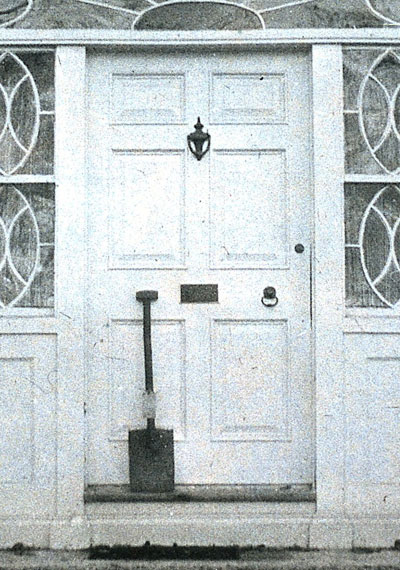 Among the artifacts in the Middlesex Canal Museum, there is a Spade believed to have been used on September 10, 1794 by Loammi Baldwin, Supervisor of Construction, to initiate the building of the Middlesex Canal. But what evidence do we have that this is “The Spade”?
Among the artifacts in the Middlesex Canal Museum, there is a Spade believed to have been used on September 10, 1794 by Loammi Baldwin, Supervisor of Construction, to initiate the building of the Middlesex Canal. But what evidence do we have that this is “The Spade”?
An earlier discussion of the Spade appeared in the January 2013 issue of Towpath Topics.1
The Spade was made available to the museum on an indefinite loan by James K. Baldwin, a descendant of Loammi. It had been in the Baldwin family for as long as anyone could remember and it certainly is the family’s oral tradition that this is “The Spade”, the actual one used by Loammi Baldwin to break ground on the day construction of the Middlesex Canal was initiated. Based on this oral tradition, alone, we have fairly high confidence that this is true. However, an element of doubt has been introduced.
There is a tag that has long been attached to the Spade. Shown on the previous page, Leon Cutler photographed the Spade with the tag by the front door of the Baldwin Mansion in the early 1930s.
Shown below, the text on the tag reads: “This spade is one of the spades that were made to excavate the Middlesex Canal prism” Authority Baldwin Coolidge 1918
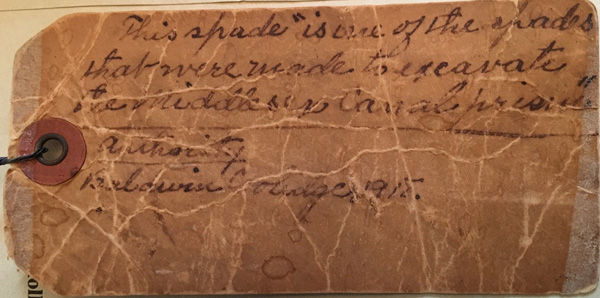 While the text certainly links the Spade to construction of the canal, the wording introduces an element of doubt that this Spade might not be “The Spade” that Baldwin himself used to initiate construction; and it may even be that it was not even used on that auspicious day.
While the text certainly links the Spade to construction of the canal, the wording introduces an element of doubt that this Spade might not be “The Spade” that Baldwin himself used to initiate construction; and it may even be that it was not even used on that auspicious day.
So, who was Baldwin Coolidge and why should this matter?
Born in July 1845, in Woburn Massachusetts, Baldwin Coolidge was a son of Mary Manning and Benjamin Coolidge; thus a grandson of Clarissa (Baldwin), who married Thomas B. Coolidge2, and a great-grandson of Loammi Baldwin, Supervisor of Construction of the Canal. Clarissa was Loammi’s daughter by Margery Fowle (Loammi’s second wife and first cousin to his first wife), and thus sister to George Rumford Baldwin, and half-sister to the other children of Loammi and Mary (his first wife)3.
The Benjamin Coolidges resided at several addresses in Lawrence, Massachusetts. Baldwin Coolidge worked for the Essex Company, apparently beginning regular work there in 1863. In 1864 he enlisted with Company K of the 6th Regiment of the Massachusetts Volunteer Militia, a Light Artillery Unit, and served for only about 100 days as a private in an 1864 campaign. He was discharged, and married Lucy Ann Plumer in February 1866. Thereafter, Baldwin Coolidge worked as an engineer for the city of Lawrence, becoming its first City Engineer in 1874.4
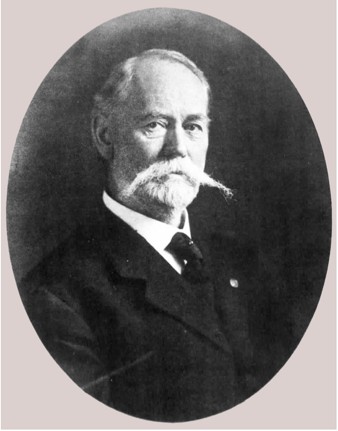 Pictured right, in 1878 Baldwin made a career change to become a photographer, opening a studio first on Tremont Street in Boston, later moving to Boylston Street. In addition, he was staff photographer for Boston’s Museum of Fine Arts for thirty years. As a photographer, he produced more than 20,000 negatives during his lifetime.5
Pictured right, in 1878 Baldwin made a career change to become a photographer, opening a studio first on Tremont Street in Boston, later moving to Boylston Street. In addition, he was staff photographer for Boston’s Museum of Fine Arts for thirty years. As a photographer, he produced more than 20,000 negatives during his lifetime.5
Coolidge returned to his native city, Woburn, and lived in a Baldwin family house, at 784 Main Street, from 1889 to 1908 while still maintaining his Boston studio. In 1917, when his health declined, he left New England to live with his daughter Marie in Pasadena, California. Resuming his artistic vocations, Coolidge sketched and painted in watercolors. He died in 1928, and his ashes were returned to his hometown of Woburn for burial.6
Baldwin Coolidge was obviously an intelligent and accomplished individual. For several years he lived in the family home where he would have had ready access to the Spade and certainly would have heard the story surrounding it. Then, about 10 years after moving out of the family home, and a year after he moved to California he attached (or had someone else attach) the tag to the spade. What motivation might he have had to do this, which now casts an element of doubt about the auspicious role that the Spade is thought to have enjoyed? What was he trying to tell us? We may never know.
Two thoughts about the spade: shown below. The MCA owns two spades associated with construction of the canal. One (R) is long-handled and relatively light weight (and currently on indefinite loan to the National Canal Museum in Easton PA) such that it is reasonable to think it probably was used during construction or subsequent maintenance of the canal. The other, the focus of this article (L), is short-handled and heavier; so short-handled in fact, that one needs to bend over to use it. It might suffice for a ceremony, but it would not be a practical shovel to use in construction. Both shovels have a flat, not pointed, cutting edge such that neither would be very suitable for digging in hard earth. (This may only reflect how early shovels were constructed, see “Making a Shovel”, footnote 1. It may also suggest that, using practices of those times, other means, e.g., picks and/ or ploughs, were used to loosen soil, and shovels were then used only to move it once loosened.)
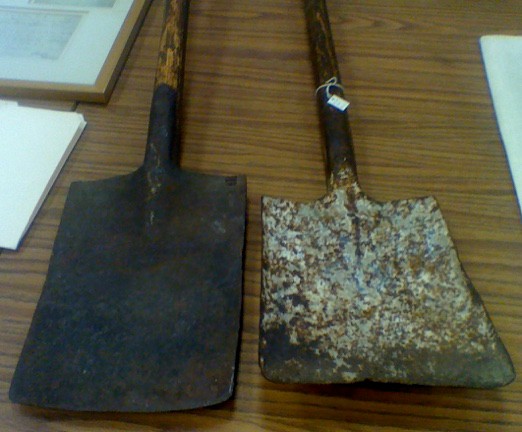 As for me, personally? I’m inclined to go with the Baldwin family’s oral tradition, that this is, at least, “A Spade” that was used to initiate construction of the canal. Why else would Loammi Baldwin have brought it home and why would the family have kept it for two centuries?
As for me, personally? I’m inclined to go with the Baldwin family’s oral tradition, that this is, at least, “A Spade” that was used to initiate construction of the canal. Why else would Loammi Baldwin have brought it home and why would the family have kept it for two centuries?
References:
2. Based on information provided by Baldwin Family genealogist Susan Williams
3. See “a Family Thing”, http://middlesexcanal.org/towpath/towpathtopicsMar2012.htm
4. McLaughlin, Jane A. “Baldwin Coolidge, Photographer 1845-1928.”
6. Reichlin, Ellie. “Double Exposure and William Sumner Appleton”, Old-Time New England 69, no. 255 (Winter/Spring 1979) : 34-41
News from the MCC Billerica Section
Andy Bowen has arranged for this year’s care and maintenance of the Middlesex Canal wayside marker site on High Street in North Billerica. In addition to mowing the lawn, the ever-encroaching vegetation was cut back, new plantings and bark-mulch were added, and plans were completed to cut the grass every three weeks. The MCC: Billerica Section plans to donate $600 to this initiative.
The MCA recently received from Marcelyn Reeves a gift of 2.53 acres of land located at 194 Salem Road in Billerica. The acreage includes approximately 100 feet of tow path. The necessary funds ($125) to ensure that the deed for the donated land was properly recorded were provided by the Billerica Section. Marlies Henderson took time from her busy schedule to deliver the necessary documents to the Registry of Deeds in Lowell.
The commission members were saddened to learn of the death of Richard Fox, Deb’s husband. Although not an official member of the MCC: Billerica Section, Rick would often attend the Commission meetings. Gifts to the MCA Museum Fund have been made in his name.
Members: Alec Ingraham, Chuck Anderson, Deb Fox, Andy Bowen, and Marlies Henderson
MISCELLANY
Proprietors and Associates will not be receiving renewal notices this October. Instead, these Renewal Notices will be sent out in April 2018, with Second Notices sent in July 2018. At this year’s Annual meeting a change in the Association’s By-Laws was made. It was voted to raise the fee for becoming a Proprietor from $20 to $25; and a Member/Associate from $10 to $15. We’ve also made the decision to change the Membership year in the Association from October 1st until the next October, to April 1st until the following April.
Back Issues - More than 50 years of back issues of Towpath Topics, together with an index to the content of all issues, are also available from our website http://middlesexcanal.org/towpath. These are an excellent resource for anyone who wishes to learn more about the canal and should be particularly useful for historic researchers.
Back Page - Excerpt from an August,1818, drawing (artist unknown) of the Steam Towboat Merrimack crossing the original (pre-1829) Medford Aqueduct, probably on its way to service on the Merrimack River.
Estate Planning - To those of you who are making your final arrangements, please remember the Middlesex Canal Association. Your help is vital to our future. Thank you for considering us.
Museum & Reardon Room Rental - The facility is available at very reasonable rates for private affairs, and for non-profit organizations to hold meetings. The conference room holds up to 60 people and includes access to a kitchen and restrooms. For details and additional information please contact the museum at 978-670-2740.
Museum Shop - Looking for that perfect gift for a Middlesex Canal aficionado? Don’t forget to check out the inventory of canal related books, maps, and other items of general interest available at the museum shop. The store is open weekends from noon to 4:00pm except during holidays.
Nameplate - Excerpt from an acrylic reproduction of a watercolor painted by Jabez Ward Barton, ca. 1825, entitled “View from William Rogers House”. Shown, looking west, may be the packet boat George Washington being towed across the Concord River from the Floating Towpath at North Billerica.
Web Site – The URL for the Middlesex Canal Association’s web site is www.middlesexcanal.org. Our webmaster, Robert Winters, keeps the site up to date. Events, articles and other information will sometimes appear there before it can get to you through Towpath Topics. Please check the site from time to time for new entries.
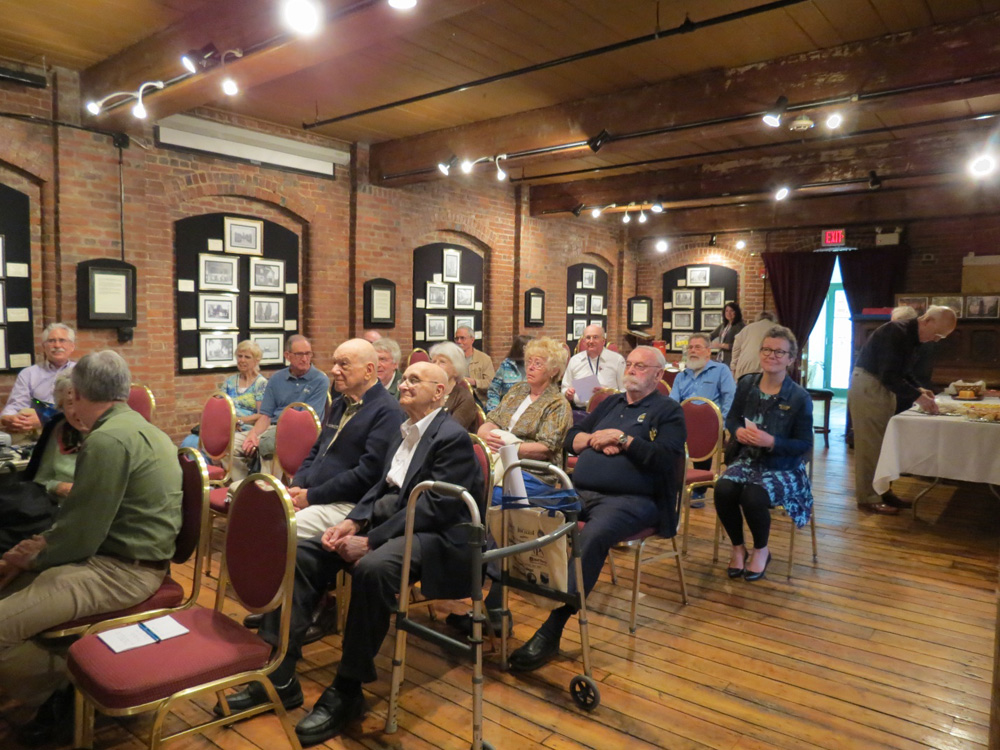
Tom Raphael seated second row, first seat at MCA Annual Meeting, April 30, 2017.
Thank you for your dedication to the MCA and MCC. You will be missed.
The first issue of the Middlesex Canal Association newsletter was published in October, 1963. Originally named “Canal News”, the first issue featured a contest to name the newsletter. A year later, the newsletter was renamed “Towpath Topics.”

Towpath Topics is edited and published by Debra Fox, Alec Ingraham, and Robert Winters.
Corrections, contributions and ideas for future issues are always welcome.
Review of Alan Seaburg’s
A Social History of the Middlesex Canal
by Howard Winkler
This book can be thought of as an extension of Alan Seaburg’s most recent canal book, Life on the Middlesex Canal. Most Middlesex Canal writings are focused on the engineering, financial, and commercial aspects. In contrast, Seaburg focuses on people related to the canal, impact of the canal on society, and historical events related to the canal.
To call the Middlesex Canal America’s First Major Canal is in my opinion regional chauvinism. The Santee Canal in South Carolina which connected the Santee River to the Cooper River and to Charleston was 22 miles long, had ten locks, and was completed in 1800. This engineering feat, however, is disgraced since it was built by slave labor, but then almost all significant structures in the anti-bellum south were built by slave labor including the White House.
The most significant contribution of this book is the chapter about American Slavery and the Middlesex Canal. Northerners felt virtuous as never having owned slaves, but the economy of the north reaped the benefits of the output of slavery and providing goods and services in support of the slave economy as the author explains. Seaburg does not mince words when he discusses slavery and its stain on our democracy.
I was charmed to read among many biographies of 19th century persons connected to the canal, and the biographies of Marion & Stuart Potter and Nolan Jones. There are 18 interesting biographies. Only two biographies of persons mentioned in the first pages of Chapter III, Personalities and Promotion, in Robert’s book were included, and they are Christopher Gore and James Winthrop. On the occasion of the formation of the canal, businessmen from Medford united with James Sullivan to develop a scheme for connecting the Merrimack River with Boston Harbor. Five members of the Hall family were in this group, and I would presume that Ebenezer Hall, a slave owner would have been among them.
The layout of this social history is unorthodox, in that it does not have Chapters, but Interludes which are only to be found in some modern novels, and are not appropriate in history books, in the opinion of this reviewer. There are many references in the book, and these demonstrate the depth of research by the author.
We are very fortunate to have a resident artist, Tom Dahill. Two of his wonderful murals, The Dock and Middlesex Village are on exhibit at the Middlesex Canal Museum, and a third mural, The Canal that Bisected Boston, is on display at One Canal Street in Boston. There are at least three levels of observing these murals. The first level is that of viewer who has little or no knowledge of the canal. The second is that of a viewer who has knowledge about the canal and its history. The third is detailed knowledge by someone, the author, who has worked with Tom Dahill, the painter, and informs us on the pages of this book details that the casual observer would possibly overlook.
This reviewer found a few small problems with Seaburg’s book, but its deep research makes a very important contribution to the history of the Middlesex Canal.
The book is available as a free PDF download at https://www.anneminiverpress.com/online-editions-list.